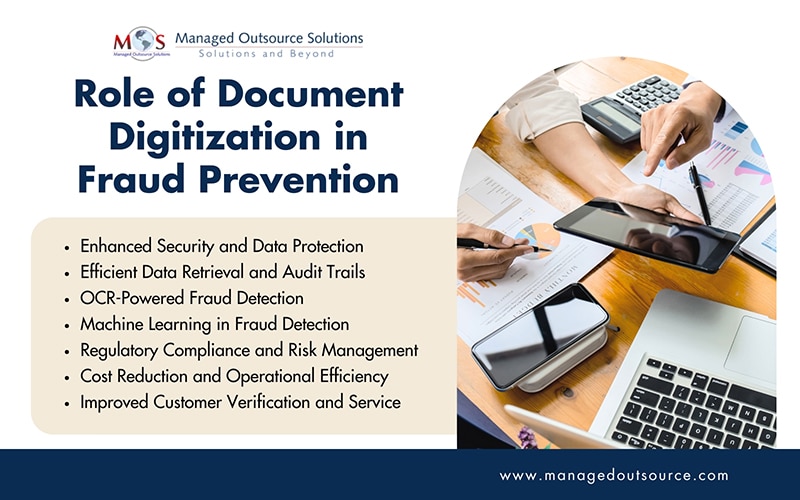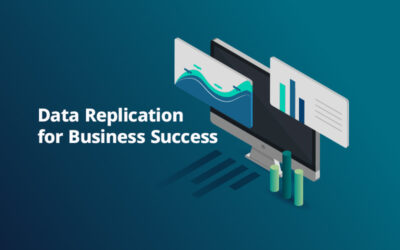In today’s digital era, fraud prevention has become a top priority for banks and financial institutions. Financial institutions generate a huge volume of data, from customer transactions and stock market data to loan and mortgage data, investment portfolios, financial statements and more. Digital document management poses high risks of fraudulent activity. With increasing instances of identity theft, money laundering, and fraudulent transactions, banks must adopt robust measures to safeguard their operations. Document digitization services play a key role in helping banks ensure financial data security. By scanning physical documents and converting them into digital format, banks can enhance security, improve efficiency, and ensure regulatory compliance.
According to data from the Association of Certified Fraud Examiners (ACFE), around 10 percent of fraud schemes in the banking and financial services industry are categorized as financial statement fraud. BioCatch’s 2024 AI, Fraud, and Financial Crime Survey revealed that 58 percent of respondents spent between USD 5 million and USD 25 million in 2023 on operational costs for investigating, combatting, or rectifying the consequences of financial crime. AI-based anomaly detection systems in finance can help in identity theft prevention, detect fraudulent transactions to safeguard against financial losses and ensure regulatory compliance. With the rate of document fraud increasing, digitizing systems act as a strong line of defence against criminal and fraudulent activities.
Role of Document Scanning in Bank Fraud Prevention
Bank fraud detection and prevention refers to the collective policies, protocols, procedures, and technologies financial institutions leverage to protect their assets, systems, and customers against fraud. Among these technologies, document scanning plays a critical role by converting paper-based customer records, application forms, and transaction documents into secure digital formats.
Document conversion services use advanced verification technologies such as artificial intelligence (AI) and optical character recognition (OCR) to extract, structure, and verify data. OCR extracts text from scanned documents and images, while AI and machine learning improve accuracy by recognizing patterns, detecting errors, and classifying documents. Banks are using AI and OCR to detect banking fraud.
Document scanning enhances transparency, speeds up fraud investigations, and ensures secure, centralized access to customer and transaction records. AI-driven tools can cross-check extracted data against predefined rules or databases, significantly reducing the likelihood of fraud.
Here’s how electronic documents improve bank security:
Enhanced Security and Data Protection
Paper documents are prone to theft, forgery, and unauthorized access. Document digitization services ensure that sensitive information is protected through encryption, multi-factor authentication, and secure access controls. As digital records can be tracked for access and changes, they limit opportunities for tampering and reduce internal fraud.
Digital records can be stored in secure cloud-based systems with robust security protocols and restricted access, ensuring that only authorized personnel can retrieve or modify them. Banks can quickly verify identity and detect forged documents using OCR and image recognition tools. Moreover, digital backups ensure business continuity and data recovery in case of cyberattacks or system failures.
Efficient Data Retrieval and Audit Trails
Managing vast amounts of physical records increases the risk of document misplacement or manipulation. A digitized document management system enables immediate retrieval of records using indexed search functions. Every document stored digitally carries metadata, timestamps, and access logs, ensuring a transparent audit trail. Maintaining consistent audit trails reduces the risk of lost or altered records.
OCR-Powered Fraud Detection
Optical Character Recognition (OCR) technology helps in fraud detection by enabling the automatic extraction and analysis of textual data from various documents, such as invoices, receipts, and bank statements. By digitizing and processing these documents, OCR systems can quickly identify anomalies and inconsistencies that may indicate fraudulent activity. This technology allows for real-time monitoring and verification, reducing the reliance on manual checks and increasing the accuracy of fraud detection. Key aspects of how OCR works include:
- Data matching: Extracts relevant identity and financial data from documents and validates them with available databases to spot inconsistencies and manipulated entries.
- Image analysis: Identifies images within documents and examines metadata, resolution, and potential digital alterations to detect tampering.
Machine Learning in Fraud Detection
Machine learning models improve fraud detection capabilities by learning from past fraud attempts. As fraud tactics evolve, these models adapt by analyzing behavioral data, consortium data, and internal and external sources. This helps banks navigate the increasingly complex fraud landscape and deliver more proactive protection to their customers and assets.
Regulatory Compliance and Risk Management
Banks are required to comply with strict regulations such as Know Your Customer (KYC) and Anti-Money Laundering (AML) laws. Integrating scanned data with fraud detection software flags anomalies in KYC or loan applications. Digitized records ensure compliance by maintaining tamper-proof, easily auditable documentation. Document conversion services assist in tracking customer interactions, verifying credentials, and ensuring that all regulatory guidelines are met. Automated compliance monitoring tools help financial institutions adhere to reporting requirements and minimize human errors, reducing the risk of regulatory penalties.
Cost Reduction and Operational Efficiency
Maintaining physical documentation requires extensive storage, administrative oversight, and security measures, all of which increase operational costs. By adopting document digitization services, banks can significantly reduce these expenses. Business process outsourcing firms provide cost-effective solutions for bulk document scanning, indexing, and secure storage, allowing banks to allocate resources more efficiently. Digitization also improves workflow automation, reducing manual errors and enhancing overall efficiency.
Improved Customer Verification and Service
Customer onboarding and verification processes often involve multiple document checks, leading to delays and inefficiencies. Digitized documents improve compliance with regulatory standards, such as anti-money laundering (AML) and know-your-customer (KYC) requirements. They enable instant identity verification, cross-referencing customer details with national and global databases in real-time. This speeds up processes such as account openings, loan approvals, and fraud investigations. Furthermore, digitized records enhance customer service by providing bank representatives with instant access to customer histories, improving response times and satisfaction levels.
Strengthening Banking Security with Document Digitization
In an era where cyber threats and financial frauds are on the rise, digitization is not a convenience but a necessity for safeguarding banking institutions against fraudulent activities. Document digitization services play a crucial role in mitigating the risks. These services convert physical paperwork into high-quality, searchable digital files, enabling secure storage, quick retrieval, and seamless integration with fraud detection systems and compliance workflows. They follow best practices for digitizing sensitive banking documents, ensuring documents are scanned at a quality that supports OCR accuracy, allowing content to be indexed and searched efficiently. With robust document scanning solutions, banks can create a fraud-resistant, transparent, and efficient information environment that supports long-term data governance and customer trust.
Partner with experts in document digitization services.
Get in touch with us now and take the first step towards a fraud-proof organization.





